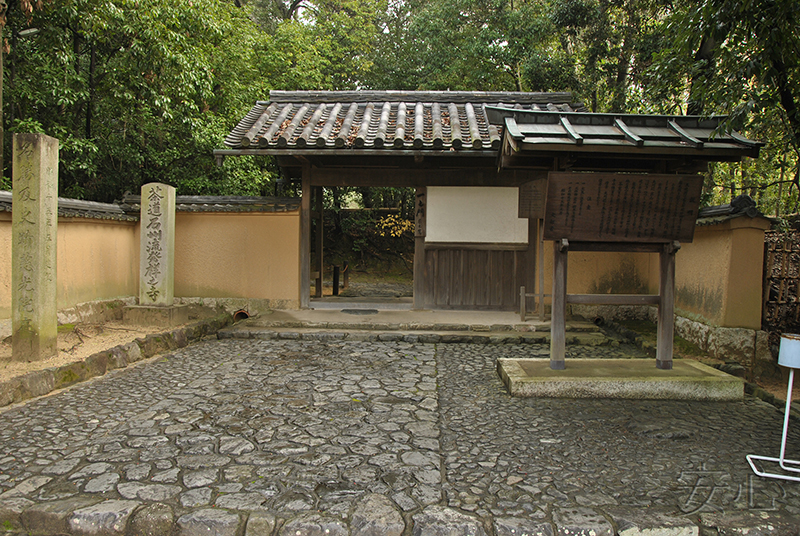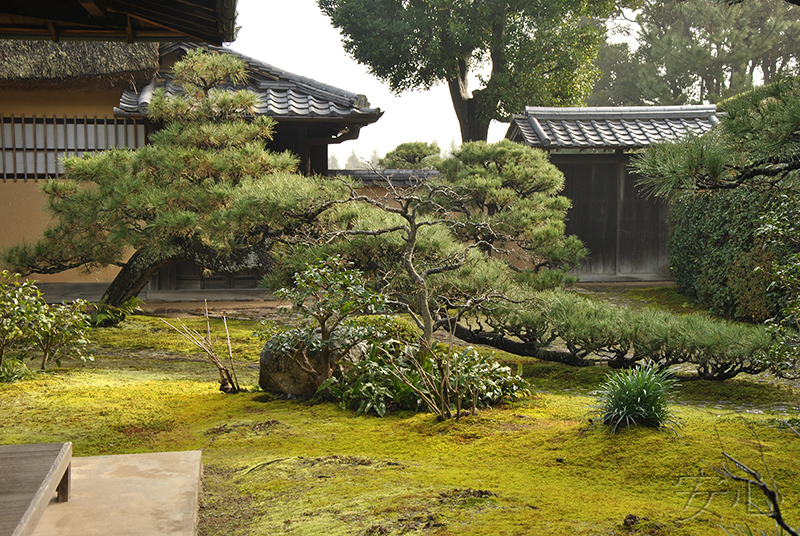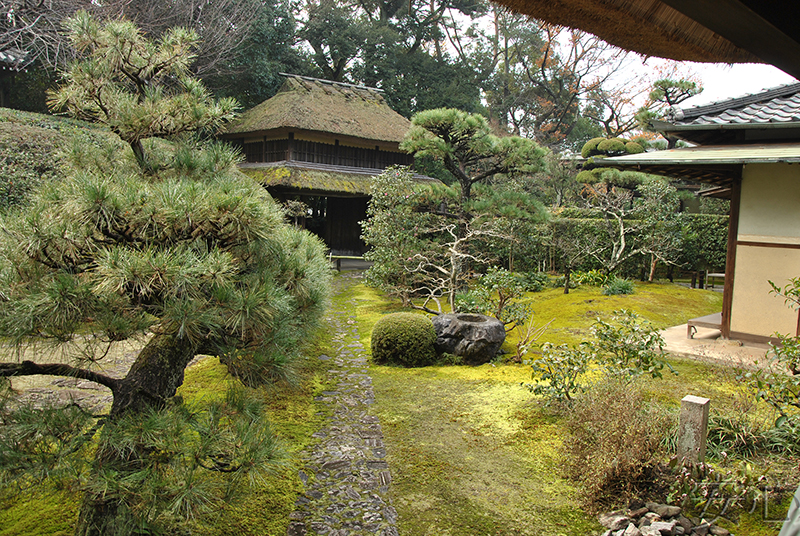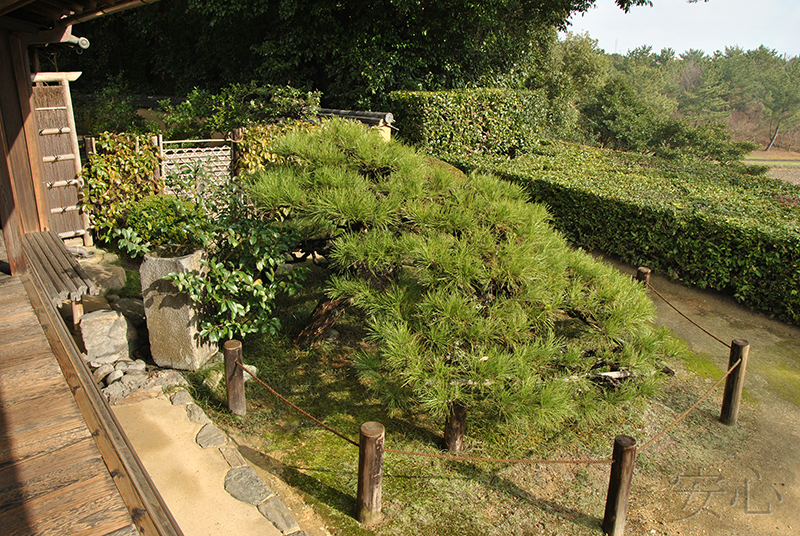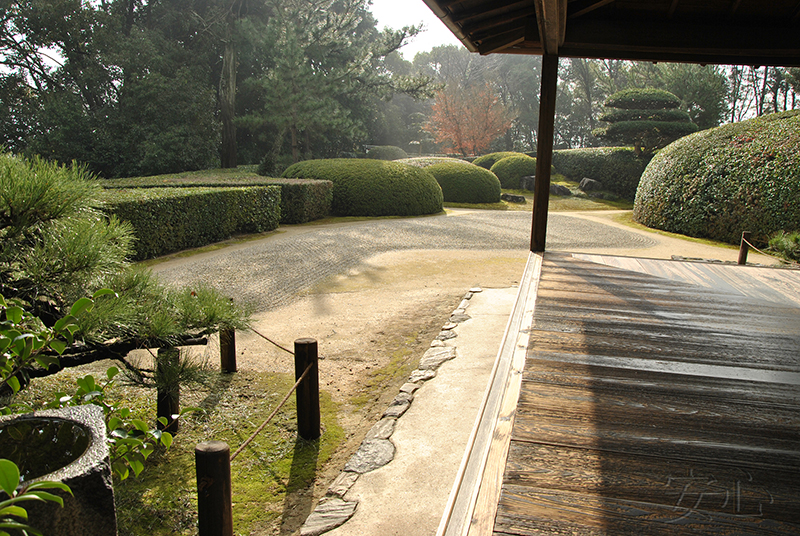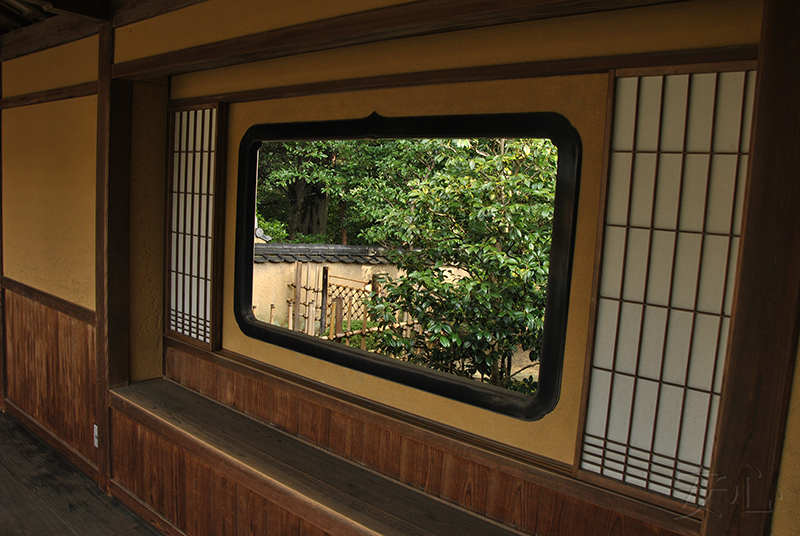
Jiko-in temple garden
Jiko-in was one of the main goals of our visit to Nara. In addition to the beautiful garden, it was interesting for me to see and feel what Nitschke writes about in one of the chapters of his book "Japanese Gardens". He examines the various techniques what designer uses to expand the space
Jiko-in is not in Nara itself, you need to go by train to the town Yamatokoriyama. It is just a couple of stops. We left early in the morning. We were very lucky with the weather that day: the rain stopped and the sun came out, although it was still cold in winter. True, Japanese gardens are beautiful both in the rain and in the snow, and to take pictures in cloudy weather much better. But on this December morning we enjoyed the sun and the warmth that it gave to us.
We found the garden very easy using google maps. The sign pointer, however, was in Japanese. In those gardens that are not very popular, it often happens that there are no signs or brochures in English, and even the staff speaks only their native language.
Further we saw the very long corridor what Nitschke writes about. He notes that the area of the garden is quite small, and it seems that a half of it is the approach to the garden. This technique creates a visual illusion that helps to prepare the visitor for the main goal, a place of rest and meditation.
However, here is still quite light and spacious. In addition, the left side of the hedge is trimmed quite low so that the trees outside are visible. There are also small "windows".
Soon we reached the first gate. And again, all the information on the stands is in Japanese! Although I did find one small tablet in English. With the name of the garden and a couple of phrases about it.
In theory, behind these gates, visitors should feel discomfort and accelerate their pace.
After the gate, the picture really changes. Now we are moving through a shady corridor. The trees at the top nearly close, covering almost the entire sky. The path itself is sunk down, the roots of trees protruding on the slopes add a thrill to the sensations. Most likely, in cloudy weather, visitors will really try to get through this corridor as quickly as possible, and from the feeling of discomfort the path will seem longer. But the good weather helped us. The sun's rays still filtered through the tree tops, creating a soft and interesting lighting.
Thanks to the turns (there are two of them), you lose the sense of distance. Since the goal is not visible, it seems that you are on the road a little longer than in reality. Although in fact, with a normal pace and without stopping, the journey takes only one minute and fifteen seconds! I specifically filmed the passage along the path and checked it.
And here we are in front of the second gate, the two-story Ibaraki-mon.
It seems that the garden is already beginning behind this gate. The path forks. The left side leads to the office.
The passage to the right is closed. You can only admire the pine tree, what forms a kind of vista from this side.
Looking ahead, I will show this pine from the side.
And from behind. From here you can see a stone bowl with water.
But I took these pictures much later. Now we passed to the office and ... did not find anyone there. My attempts to call someone were unsuccessful. It seemed that we were alone, and there was no one around.
Perhaps, we thought, this is not the main entrance, and tried to go around the building on the left. There we found a garden covered with autumn leaves with a stone lantern and a tsukubai.
And that's all. There was no further passage. We went back to the office and finally saw a female worker there. She greeted us, showed us where to take off our shoes.
It was a big mistake not to take warm socks with us. It is very cold in December, and walking in unheated, open rooms in thin socks is not only cold, but also a great chance to catch a cold. The only warmth was on the wooden flooring, where the sun's rays fell.
We bought tickets. By the way, visiting this garden is quite expensive, compared to many others, 1000 yen. But the garden is worth it! We realized this as soon as we entered the drawing room. The scenery we saw is breathtaking!
Everything is so beautiful, so perfect, and even the rays of the morning sun seemed to illuminate the garden exactly as the author intended. We were torn between the desire to photograph this beauty and just sit and gaze at the garden.
The name of the garden, Jiko-in, what literally means "gentle light". This name suits it so much!
Our delight was suddenly interrupted by a female worker. She asked us to sit down and to put in front of us a plate with a couple of sweets, gave us the pieces of paper and gestured that we need to put sweets on a paper.
Then the girl left and returned again, now with two cups of matcha tea. She put them in front of us, and, offering to enjoy a drink, left the room. We love the taste of matcha tea, but here, surrounded by such beauty, it seemed just divine!
After drinking tea, we decided to take a closer look at the garden. The largest bush-hemisphere on the right is the most impressive.
What can be seen from the engawa is only half of this giant plant! It goes through the fence and extends to the other side.
This photo was taken from the other side of the fence.
Of course, this huge hemisphere was not created from one bush. Leaving the garden, I came closer to it and photographed what was inside. It can be seen that there are a lot of shrubs collected together, which are cut into one shape.
But back to the southern garden. At the right end of the corner terrace there is a tall bowl of water surrounded by low bamboo.
There is another bowl at the left end. A pine tree grows next to it.
You can see the gate behind the pine tree. But what is after it, we did not know yet, because it is not allowed to walk in the garden, we can only be on wooden flooring.
View of the garden from this corner.
At that moment, the girl appeared again. Like a sorceress, she pushed one of the doors, and we saw another garden on the opposite side of the house. It was a small courtyard surrounded by buildings on all sides.
But that was not all. Passing the window, we found that outside was the same part that was hidden behind the gate.
A small nook was separated by another fence from another part.
A little further there was a door, exit to the engawa.
Right part.
And the left side.
Returning back, we examined the courtyard from the opposite side. In the center is the Kan tea house. Particularly noteworthy are the large stone and the formed pine. Three smaller stepping stones lead to the stone from the one side and another two from the other side.
Apparently, from this large stone the garden is examined. All stones are cleanly washed, as people walk on them without shoes. Even with us, the girl diligently wiped them.
Pine is just a beauty!
Reaching this pine, we discovered the second surprise - another patio.
There is a room with an altar in the main building of the temple with three figures opposite the entrance. In the center is a statue of Buddha. On the right is a monk of the Daitoku-ji temple Gyokushu who preached the path of Zen Buddhism and the tea ceremony, where "the beauty of wabi" is on the first place. On the left is a statue of Sekishu Katagiri, the founder of the Jiko-in temple, who was the daimyo of this area. He erected a temple to pray for the happy life of his father's soul.
It's prohibited to enter the room, but it was clear that there were more rooms on the right and left.
A girl came up to us again and drew our attention to the dragon painted on the ceiling. Unfortunately, she didn't speak English, so we never knew what this dragon meant. Indeed, in such a place, nothing can be just like that. Moreover, the Dragon is one of the main symbols of Zen.
I'll also add a photo of the courtyard view from the third corner.
As much as we wouldn't want to wander here longer, but we had to leave. The reason was trivial: our feet were very cold. If it were not for this annoying circumstance, we would have sat in this magical garden for a long time.
On the way back, closer to the exit, we noticed another tea room.
We walked under the impression of what we saw. Perhaps this is not the most famous garden, maybe there are more beautiful and famous ones, but here we experienced a real immersion in Zen, in peace and quiet, in beauty and mysticism. And a significant role in this was played by the worker of the temple, who seemed to lead us along a certain path.
Later I remembered a quote from Nitschke, when he wrote about this garden: “In Jiko-in shoin our bodies seem to float in space and our vision to extend for miles, and we pause and are still. It is a feeling experienced by almost every visitor. We are invited to meditate, to experience the vastness of inner space. We slow cease to perceive the outside world, and in doing so relinquish the awareness of self. We are thus made aware of awareness, which is empty and hence the ultimate extension of space. ... "
Garden Information:
Address: 865 Koizumicho, Yamatokoriyama, Nara 639-1042
Opening hours: from 9.00 a.m. to 5.00 p.m.
Saturday - culture day (opening hours may vary)
anshin©2011All rights reserved. When using the materials of the site, reference is obligatory.
Proposals for co-operation, as well as comments and suggestions on the site please send to the address: anshinsad@gmail.comtel: +7 (965) 121-80-60, 10am-20pm



